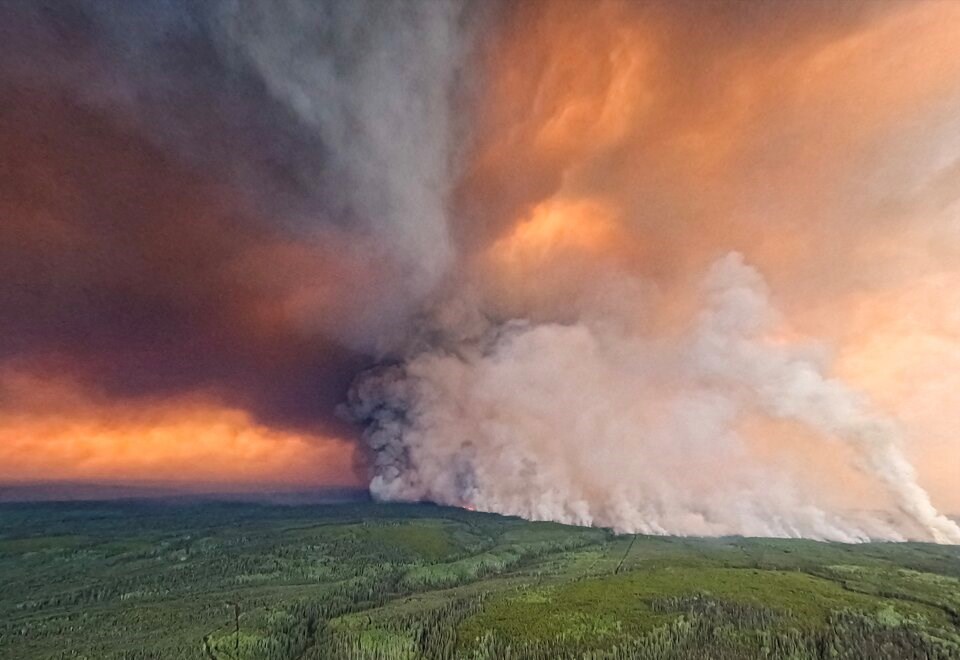Canada’s 2023 wildfire season dropped air quality across the country to levels so bad, for the first time, it fell below the United States in regional pollution rankings, a new report has found.
The report, from the air quality monitoring service IQAir, found North America’s 13 most polluted cities in 2023 were all located in Canada.
“Unhealthy and hazardous air quality was recorded in the Great Lakes, Midwest, East Coast, and Pacific Northwest after Canadian wildfire smoke drifted south,” the study said.
“Schools closed and companies encouraged employees to work from home. In one incident, wildfire smoke travelled from Alberta to Quebec, over the Atlantic Ocean, and returned west, leading to hazy skies and poor air quality in Florida.”
The report focused on fine particulate matter, or PM2.5, which gets its name from the particles less than 2.5 micrometres in diameter that get vaulted into the air from wildfires, wood-burning stoves, and the combustion of fossil fuels.
B.C. city had fourth most polluted air in North America
As the 2023 fire season accelerated through May, PM2.5 levels in Alberta surged nine-fold compared to the previous year, the IQAir report found.
Fort McMurray and Peace River, Alta, were found to be the two most polluted cities last year. The Northwest Territories capital city of Yellowknife, which was fully evacuated as wildfires bore down on the northern community last summer, came in third.
In British Columbia, Fort St. John ranked as having North America’s fourth most polluted air in 2023, while Prince George rounded out the list of top 15 most polluted cities on the continent.
Both cities sit in the vicinity of the Donnie Creek wildfire, an inferno that burned an area larger than the province of Prince Edward Island, and was by far B.C.’s most destructive wildfire ever recorded.
As any resident of Western North America knows, where wildfire smoke ends up changes with prevailing weather conditions throughout the fire season.
In 2023, almost all of North American cities with the cleanest air were in the United States. Khei and Waimea, both in Hawaii, as well as Durango, Colo., were found to be the least polluted.
Prince Rupert, which sits on B.C.’s north coast, was the only Canadian city among the top 15 cities with the cleanest air.
Wildfire's impact on public health growing but still unclear
The IQAir report found 41 per cent of Canadian cities recorded annual PM2.5 levels above 10 micrograms per square metre. That’s twice the set by the World Health Organization (WHO).
Another 35 Canadian cities were found to have exceeded the WHO PM2.5 guideline by a factor of three. The number of cities that met the annual WHO guidelines dropped by nearly a third in 2023, to 23 cities from 61 the previous year.
Historically, exposure to air pollution in Canada lead to nearly 8,000 deaths per year, according to from Michael Brauer, a professor at the University of British Columbia's school of population and public health. Brauer says scale and magnitude of the 2023 wildfire season could lead that number to balloon over the coming years.
Brauer said one to several days of wildfire smoke exposure accounts for somewhere around 10 to 20 per cent of health impacts across Canada.
“More people will die on those days,” said Brauer.
The bigger and unanswered question is around day-in-day-out exposures, and how they contribute to things like heart disease and lung cancer, the researcher said.
“We don’t really know that for wildfire smoke,” he said. “Now, pretty much everyone in Canada is going to get a week or more of smoke once every two or three years.”
“All signs point to that being just as bad as [urban air pollution].”
'It's the future'
Jack Chen, a research scientist at Environment and Climate Change Canada’s Air Quality Research Division, said results from the IQAir report are not surprising.
In a recent pre-print , Chen and several other federal and university researchers concluded that between May and October 2023, mean temperatures across Canada were 2.2 degrees Celsius warmer than the previous 30 years.
Those hot temperatures drove sustained extreme fire weather which ultimately burned 15 million hectares of forest, or four per cent of Canadian forests — far more than the previous record of 6.7 million hectares that burned in 1989, Chen and his colleagues found.
Burning land roughly half the size of Italy inevitably produced a lot of smoke. Between 2017 and 2022, Canada averaged roughly 1,300 alerts due to the extreme poor air quality conditions during the wildfire season. In 2023, that spiked to about 5,000 alerts, Chen and his colleagues found.
“It has a tremendous impact, and that’s not putting it lightly,” said Chen. “The smoke that’s being produced is a continental problem.”
That problem is inextricably linked climate change. In May 2023, a study found that nearly 40 per cent of the area burned by wildfires in Western Canada and the United States over the last four decades were caused by emissions from the world’s top fossil fuel producers and cement manufacturers.
“If the trend holds — and this is what we see from many studies — we expect wildfire seasons to get longer and more intense,” said Chen. “If we’re going to have fires, we’re going to have smoke.”
Or as Brauer put it: “Wildfire smoke is our air quality issue in Canada. It’s just going to be a more regular occurrence. It’s the future.”



